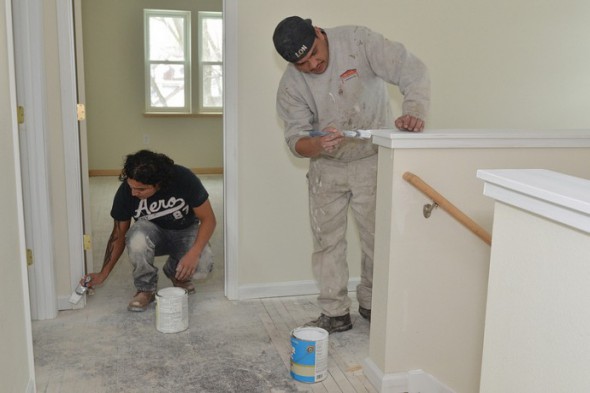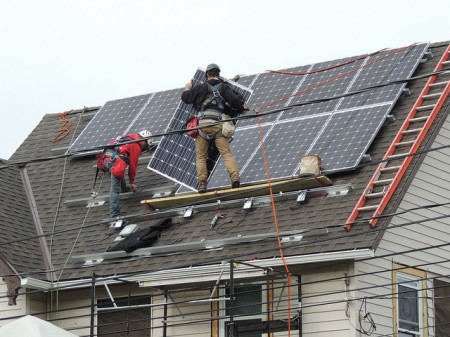The House With No Energy Costs
Renovation of foreclosed South Side duplex equips it with solar and other upgrades, now has no energy bill.

Ricardo Avila and Rodolfo Garcia add a fresh coat of paint to the interior of the renovated home on South 33rd Street. (Photo by Sue Vliet)
Renovations at 2010 S. 33rd St. go beyond fresh paint, new windows and flooring. Over the last seven months, contractors and volunteers have worked to transform the vacant foreclosed duplex into a single-family energy-efficient home.
Since 2008, the Turnkey Renovation Program at Layton Boulevard West Neighbors, Inc. (LBWN) has renovated vacant foreclosed properties. The homes are sold to a family who will live in it, helping to stabilize the neighborhood.
“We saw investors aggressively purchasing [vacant foreclosed] properties, and we were concerned that would deteriorate the neighborhood,” said Project Manager Jeremy Belot.
The 33rd Street home is the 12th to be renovated in the Turnkey Renovation Program and is unique for its energy-efficient features. According to Belot, the goal is to transform the home so that it produces as much energy as it consumes, resulting in a net energy bill of zero.

Contractors install solar panels to make the renovated house more energy efficient. (Photo courtesy of LBWN)
Equipped with solar “photovoltaic arrays,” or solar panels, and a solar thermal water heating system, the house will be able to produce hot water and electricity. Triple-paned windows, double insulation and ceiling fans also have been added throughout the house to keep energy bills down.
Karl Harris, 51, was able to purchase his energy-efficient home on South 37th Street in Burnham Park with the help of LBWN more than a year ago. Thanks to its solar panels and high-efficiency water heater and furnace, he is paying less in energy bills.
“The electricity is about half of what I was paying for an apartment, and that apartment was about half the size of [my current] house,” Harris said.
The Home Energy Rating System (HERS) gives the 33rd Street house an index score of 13, relatively low when compared to newly constructed energy-efficient homes, according to Belot. According to the U.S. Department of Energy, typical resale homes have an index score of 130. Finishing touches over the course of the next month will help in reaching a score of zero.
The five-bedroom home has already attracted prospective buyers. “When you do this much work to a house, it gets attention from people,” said Turnkey Renovation Program Assistant Tim Hoye.
“When [people] are looking to buy a home, they’re looking at not just the home, but the neighborhood,” Sas-Perez said. “To have a great home … in a neighborhood that is going to support a healthy great quality of life is just a really big bonus.”
Belot said the house on 33rd Street has been one of the more difficult renovation jobs, but it also will be the most rewarding. The house was “wreck” and there was not much worth salvaging, he added. With support from US Bank, Wells Fargo, City of Milwaukee Housing Trust Fund and various other partners and volunteers, the project will be on budget.
“We’re hoping that by [renovating this home], it opens people’s eyes to what the possibilities are to taking on a foreclosed property,” Belot said.
LBWN expects to list the house at $104,000, and it will be on the market in late February.
This story was originally published by Milwaukee Neighborhood News Service, where you can find other stories reporting on fifteen city neighborhoods in Milwaukee.
















LBWN has done an excellent job on comprehensive rehabilitation of many homes including this one. There are thousands of homes and commercial businesses that could undergo this type of reconstruction. That is where many of the jobs could be in Wisconsin and nation-wide. It would cut energy consumption of buildings in 1/2 over time. That savings would go towards other areas in a local economy. Wisconsin sends over $12 Billion annually out of state for the purchase of coal, natural gas, and nuclear fuel. Every dollar saved on an energy expenditure locally is turned over two times to spur local business and the economy.
Our state has regressed in the area in the last three years due to the lack of true leadership. We have dropped from a top ten state in energy efficiency and renewable energy ranking to about 20.
Just out of curiosity, is the MREA at all involved with this initiative?
I would be interested to hear homeowners and contractors opinions about all of the green insulation materials available on the market. I have been hearing more and more criticism from builders and home improvement specialists regarding denim and cellulose insulation.
The complaints about denim include the dubious claims of recycling when denim is made from cotton and normally is re used in secondary and thrift markets while handling the material is often difficult to cut and fit properly.
Cellulose has been criticized for absorbing water like a paper towel. I am interested to know if anyone has experience with these “green” products vs. using blown in insulation or traditional fiberglass.
You may be able to find answers at the upcoming Better Building Conference in the Dells. It is put on by Energy Center of Wisconsin. Find the details on their web site.
Insulation needs to be combined with air sealing. The installer also needs expertise in what they are doing. Not all contractors perform reliable services and the work needs to be inspected with a blower door and infra red test to insure all the voids will be filled.
I have cellulose in my home and it probably fits 95% of the needs. There are more expensive products in insulation but there is a law of diminishing returns on what should be done. For instance new windows take over 25 years to return the investment on an energy saving basis but that is not the only reason to replace windows.